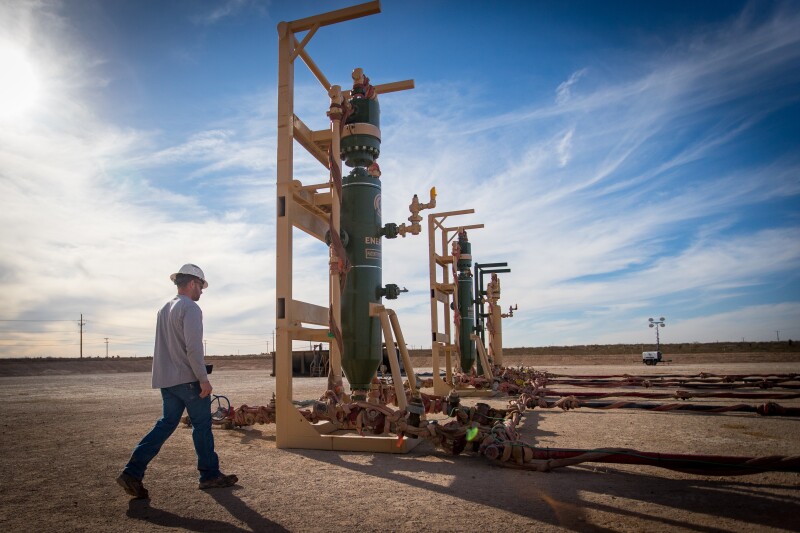In what appears to be a sign of the times for the unconventional sector, over 1.5 million lbs of frac sand was captured from a single horizontal well late last year in the Delaware Basin. The figure was reached after 71 days of uninterrupted flowback operations on a 2-mile lateral targeting the Bone Spring formation in Texas.
The supersized sand haul set a new company record for Enercorp which is celebrating the work it did for an undisclosed operator client as further validation of its newest and biggest line of cyclonic sand separators.
Adjacent to the record-setter was the runner up. The Houston-headquartered Enercorp said it recovered an additional 1.3 million lbs of sand from a well on the same pad during the project.
While outliers, perhaps, the two wells may also signal that proppant flowback is a mounting challenge for adopters of bigger and more-intensive well designs.
“As the laterals get longer, as the stages get more densely grouped, and as they pump more sand down—all of those things add to the amount of sand that is getting produced,” explained Brent Coombe.
The director of engineering for Enercorp said the company is seeing sand recoveries rise across the various North American plays it operates in. But nowhere more so than in the Delaware which, at 2.6 million B/D, is the top oil-producing subregion of the wider Permian Basin.
Public well data show lateral lengths in the play that spans Texas and New Mexico extending from about 7,900 ft in 2019 to more than 9,000 ft in 2022. That’s an increase of about 15%.
During the same time, average proppant loadings in the Delaware swelled by 23% from 17.4 million lbs to 21.4 million lbs per well.
The impact of this shift toward bigger wells has been unambiguous for Enercorp which is among the region’s most active sand management companies.
Just 2 years ago, the firm defined a high-sand producer in the Delaware as one that returned at least 100,000 lbs of proppant. “Now, 100,000 lbs is very common and I would consider a high-producing-sand job to be in excess of 250,000 lbs,” said Coombe.
Let It Flow, Let It Flow
At its peak, Coombe said the record-setting well saw sand flow top 5,000 lbs per hour which is “an extremely high rate in comparison with a normal flowback job” that tends to max out at 500 lbs per hour.
Despite the extraordinary conditions, the first of two cyclones used on the well captured in excess of 99% of the sand that flowed out of it—or 1,541,558 lbs to be exact. That’s enough sand to fill up at least 30 dry bulk trailers.
A second unit installed downstream for redundancy recovered just under 7,000 lbs. And after flowback ended, a comparatively minute amount of sand totaling less than 200 lbs was found in the test separator.
But behind all these numbers is what Coombe said is the bigger takeaway for the service company. Enercorp’s touted capture efficiency means operators can use aggressive choke strategies on high-flowing wells without being constrained by correspondingly high—or ultrahigh in this case—sand rates.
“With the Sahara, we’ve proven that we can run the choke schedule the way the reservoir engineer wants it to be run, and we don’t have to wait,” for sand levels to drop, said Coombe. “If the sand is coming in hard, we just keep going and know that the equipment can handle it.”
In elaborating on what Enercorp views as one of its biggest competitive advantages, Coombe said legacy separation technology would be overwhelmed by the totals reported in its Delaware case study.
When that happens, flowback operators face allowing their systems to suffer from excessive erosion or they can ask the operator to hold off on increasing the choke size. Too much sand may also find its way into centralized production facilities.
All of this not only impacts expectations on initial production and a well’s rate of return, but operators may be faced with chargebacks to cover any damages caused by sand to third-party production equipment.
Adapting to Shifting Sands
Cyclonic sand separators are nothing new to the industry and just one of several options for removing sand and fines prior to flowing oil and gas into a sales line.
But Coombe said Enercorp has tried to push the boundaries with both its 10,000- and 15,000-psi units that were designed using in-house models along with a physics-based approach called computational fluid dynamics. This engineering work included developing changeable inlet devices for the cyclones that enable the company to customize their operating parameters.
“Tuning the separator to work under specific conditions is the secret sauce,” and one that Coombe said becomes even more important when dealing with multiphase flow and varying temperature regimes that impact how liquids and gases will separate.
In other words, what works in the dry-gas fields of the Haynesville Shale will not be ideal for the liquids-rich oil plays found in the Permian.
Aside from these innovations, Enercorp is trying to stay ahead of the problems posed by proppant flowback and the increasing number of wells on each pad through automation.
While its biggest cyclone units require two personnel per shift to operate, Enercorp's automated flowback system needs just one person to oversee multiple locations which is helping to scale its operations. “We set up, tune the units, and then leave the site in our rearview mirror while it runs,” shared Coombe.
Since introducing the service in 2019, Enercorp has executed over 60 automated flowback operations which account for more than 3.5 million lbs of captured proppant.
